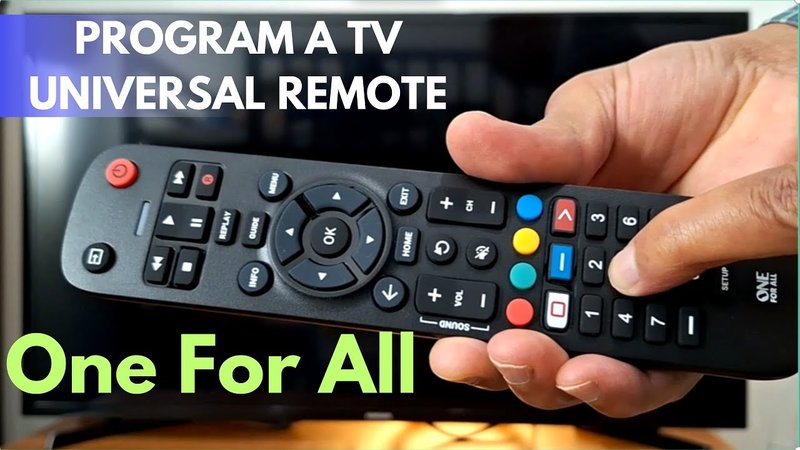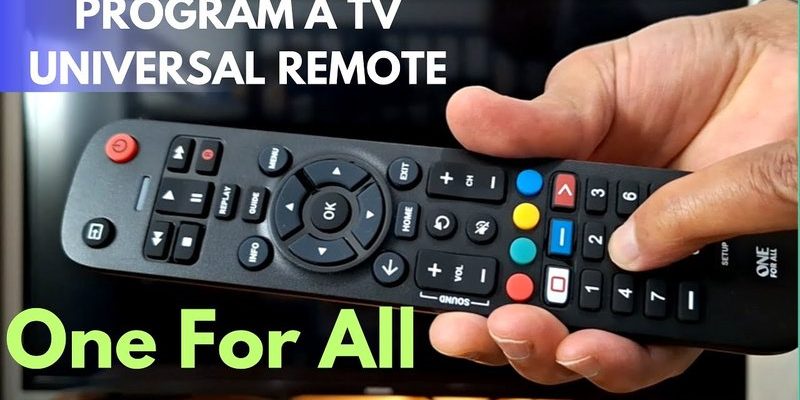
But here’s the million-dollar question: just how long does it actually take to program one of these things? Is it a quick, “before the popcorn’s done popping” kind of job, or the sort of task you tackle on a lazy afternoon with snacks and patience? Let’s unpack exactly what you’re in for, and I’ll walk you through the nitty-gritty, easy-peasy style.
What Makes the One For All Universal Remote Different?
Here’s the thing: not all universal remotes are created equal. Some are clunky, others are confusing, and a few make you wonder if inventing fire might’ve been easier than syncing your TV. The One For All Universal Remote sets itself apart by aiming for simplicity and wide compatibility. It’s designed to work with thousands of TV brands out of the box—meaning you won’t end up frustrated if your TV is older than TikTok.
What I love is how the remote is preloaded with a huge library of codes. You don’t have to be a tech whiz to set it up, either. The process usually involves a quick sequence: pop in the right code, press a few buttons, and boom! Your remote and TV are speaking the same language. No need to call in the IT department—unless you count your neighbor who “does computers.”
And let’s be real: most universal remotes rely on those tiny paper instructions (that are always missing, right?). One For All remotes often include online code lookup and a simple layout. It takes the intimidation factor way down, especially for beginners or anyone who just wants to relax and turn on Netflix already.
How Long Does The Programming Process Usually Take?
Alright, here’s what you came for. Honestly, programming a One For All Universal Remote can be surprisingly fast. For most people, it takes between **5 and 15 minutes** from start to finish. If your remote and device are good friends (meaning, the code works right away), you could be done even quicker—possibly in just 2 or 3 minutes. That’s less time than it takes to argue over what movie to watch.
Now, if things go sideways—let’s say you can’t find the right code on the first try, or you’re dealing with a stubborn old DVD player—it might stretch closer to 20 minutes. Still, that’s pretty manageable. Most of that time is spent flipping through the manual or testing codes, not sweating over complicated steps.
Here’s a quick way people usually break it down:
- Finding your device code: 2-5 minutes (sometimes longer if your brand is rare)
- Entering code and syncing: 1-3 minutes
- Testing functions (power, volume, input): 2-5 minutes
- Troubleshooting or retrying: 2-6 minutes (if needed)
So, if you’re the type who loves a clear answer: plan for about **10 minutes** (give or take), and you’ll probably be pleasantly surprised.
Step-By-Step: What Programming Actually Looks Like
Let me explain how the process usually unfolds in real life. Imagine you’ve bought your One For All Universal Remote, and you’re ready to give it a whirl. Here’s a typical play-by-play, minus the technical jargon:
First, you’ll want to make sure your remote has fresh batteries—nobody likes a dead start, right? Then, you look up the code for your TV brand from the manual or the One For All website. Once you’ve got your code, you press a special combo of buttons on the remote (like “TV” and “Power” together), then punch in the code using the number buttons.
The remote usually gives a quick blink or two to say, “Hey, I got your code.” At this point, you try the power button. If your TV turns on or off—celebrate! If not, you might need to try another code from the list or press a setup button again. Sometimes you have to repeat this little dance a couple of times, especially with trickier brands or older devices.
It’s kind of like learning a new handshake—you might not nail it the first try, but after a couple of goes, you’ve got it down. If you’re lucky, you’ll only need to sync once per device. And remember, if you ever add a new gadget to your living room, you can reprogram the remote in the same way.
Common Speed Bumps (And How To Fix Them)
You might be wondering, “What if it doesn’t work on the first try?” Honestly, hiccups happen, but they’re easy enough to fix. Here are some common issues and how to get past them:
- Batteries running low: Fresh batteries make all the difference. Trust me—I learned this the hard way after 10 minutes of nothing happening.
- Wrong code: Sometimes the first code isn’t the charm. Just try the next one on the list. Some brands have several possible codes.
- Remote or device not compatible: Rare, but possible if your device is very new or very old. One For All support or forums can help.
- Button sequence errors: If the remote doesn’t flash or respond, try redoing the steps. Sometimes you have to hold the button for a few seconds.
Pro tip: If your remote gets “stuck” or acts weird, do a quick reset—there’s a button combo for that in the manual. It’s like giving your remote a fresh start.
The Different Programming Methods: Code Entry vs. Search
You’ll usually run into two ways to sync a One For All Universal Remote: direct code entry and automatic code search. Each one has pros and cons, and the time it takes can be a little different.
**Code Entry:** This is the faster of the two, as long as you know your device brand and have its code handy. Usually, you find the code in the booklet or online, enter it using the number keys, and you’re good to go. If you’ve got a common brand—like Samsung, LG, or Sony—it’s pretty much a breeze.
**Auto Code Search:** This method takes a bit longer but can save the day if you don’t know your code. Here, you press a series of buttons and the remote cycles through codes automatically. When your TV turns off or reacts, you “lock in” the code. This can take anywhere from 5 to 15 minutes, depending on how many codes the remote has to try.
Sometimes, using auto search feels like speed-dating your remote to your TV. When you see that flicker as your device finally responds, it’s a match!
Regardless of method, patience is key. But compared to digging through a drawer for the right remote every night? Totally worth it.
How Does Programming a Universal Remote Compare To a Brand Remote?
Here’s a little perspective. If you’re comparing a universal remote (like One For All) to the original remote that came with your TV or device, programming time is the main difference. **Brand remotes** are usually ready to go right out of the box—no code, no fuss. But lose it, and replacements can be expensive or hard to find.
With a universal remote, there’s a bit of setup upfront—those 10 to 15 minutes of syncing and testing. The trade-off? You get a single controller for all your gadgets, and One For All remotes can often handle 3, 4, or even 8 devices at once. That saves you future headaches and clutter.
It’s kind of like cooking your own dinner instead of ordering takeout. Takes a little longer at first, but the flexibility (and savings) is worth it.
Tips For Easy and Fast Programming
Let’s talk shortcuts. If you want to make syncing your One For All Universal Remote go even faster, here are a few tips I’ve picked up:
- Gather device info ahead of time: Know your TV’s brand and model—it’ll help you find the code quicker.
- Check battery strength: Weak batteries make the remote sluggish or unresponsive.
- Print out or screenshot the code list: Having the codes ready (instead of flipping through a tiny manual) can save precious minutes.
- Follow the steps carefully: Don’t rush—if you miss a button or step, you’ll just have to start over.
- Test all the main functions: Make sure volume, input, and power work, so you don’t have to redo things later.
Honestly, a little prep goes a long way. You’ll spend most of your programming time double-checking that you’ve got the right code. Once you’re in the groove, you’ll be syncing remotes for friends and family like a pro.
What If You Get Stuck? Troubleshooting and Resetting
If your One For All Universal Remote isn’t cooperating, don’t panic. There are a few simple things you can try before giving up:
*Double-check you’re using the right code for your device’s exact model. Some brands have multiple codes, and just one digit off can mean no dice.*
*Try the reset function if things get weird. You can usually reset the remote by holding certain buttons for a few seconds. This wipes out all previous programming, like giving it a clean slate.*
*If nothing works, visit the One For All website. They often have updated code lists and troubleshooting guides, plus support if you need it. Forums are also packed with folks who’ve wrestled with the same problems.*
Remember: Most issues come down to either the wrong code, low batteries, or missing a step in the programming sequence.
If your remote just won’t pair, it could be a sign that your device is too new (or too vintage) for that version of the remote. In super rare cases, some functions won’t work on certain devices—just like how some universal chargers don’t fit every phone.
Final Thoughts: Is Programming a One For All Remote Worth It?
Honestly, spending 10 or 15 minutes programming a One For All Universal Remote is a small price for a big payoff. Instead of wrestling with a mess of remotes or panicking next time your original remote disappears, you’ll have a one-stop solution that keeps your living room calm and clutter-free. Sure, syncing requires a bit of patience and a careful eye for codes, but it’s way less intimidating than it sounds.
Most of us can handle it with just a bit of trial and error—no technical degree required. Once everything’s paired up, you’ll wonder how you ever managed movie night without it. So, grab your One For All remote, your favorite snack, and take those few minutes to sync things up. You’ll thank yourself every time you click “Power” and *everything* just works.
